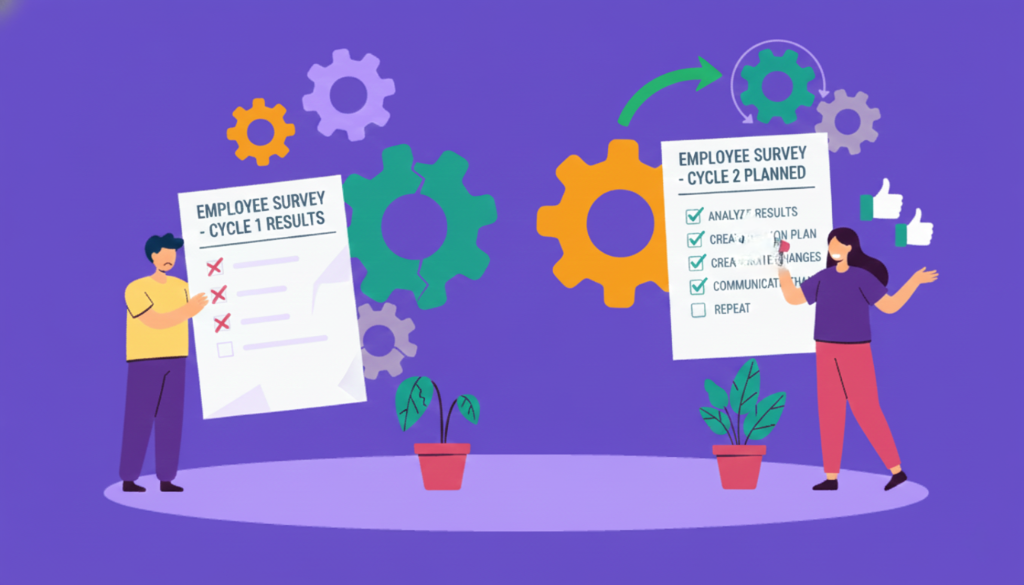Unlocking Employee Happiness: A Guide to Satisfaction Surveys

A Global Employee Recognition and Wellness Platform
When it comes to building a thriving business, nothing is more crucial than a satisfied workforce. After all, if your team feels heard and valued, their energy naturally radiates into every aspect of your organization. In fact, research from the University of Oxford shows that happy workers are 13% more productive, this statistic just goes to show how closely linked employee satisfaction and business success truly are.
In this article, we’re going to explore why employee satisfaction surveys are a must-have in any organization’s playbook. We’ll peel back the layers of what these surveys can reveal, dive into the nitty-gritty of crafting questions that get honest answers, and walk through best practices for executing them seamlessly.
Let's Begin!
Defining Employee Satisfaction Surveys

Before we get into the hows and whys of surveying, it’s important to clarify what we mean by “employee satisfaction.” Employee satisfaction is about how content someone is with their job, the benefits, the environment, the daily interactions, and even the little perks that brighten their day. It’s a holistic snapshot of their overall well-being at work. While “employee satisfaction surveys” serve as the instruments to assess this sentiment through strategic questioning.
Employee Satisfaction vs Engagement
One common point of confusion I should mention is that people often use employee satisfaction and engagement interchangeably. While they're related concepts, they're actually quite distinct measures of the employee experience. In contrast, employee engagement speaks to the emotional commitment an employee has to the organization and its goals. Engagement is that extra spark that drives someone to give their best every day. You might see a highly satisfied employee who isn’t deeply engaged, or an engaged worker who still feels there are improvements to be made in their daily experience.
Psychological Foundations of Employee Satisfaction
To truly understand what fuels employee satisfaction, it's worth looking at the following concepts:
Maslow’s Hierarchy of Needs
Picture a pyramid where the bottom layer represents our most fundamental needs, safety, security, and a sense of belonging. In the workplace, these aren’t just lofty ideals; they’re concrete requirements that enable employees to thrive. When these basic needs are met, staff can move up the pyramid, eventually reaching a level where they’re not only satisfied but fully engaged with the company’s vision. Satisfaction surveys can be an invaluable tool for identifying whether these core elements are in place, highlighting where small changes can spark big improvements in morale and productivity.
The Honeymoon-Hangover Effect
Now, let’s talk about the employee journey, especially for new hires. When starting a new job: everything feels fresh, exciting, and full of promise, the classic “honeymoon” phase. However, as the initial thrill fades, reality tends to set in, and if expectations aren’t met, employees might experience a “hangover” phase marked by disappointment or disillusionment.
This transition is crucial; by monitoring satisfaction over time, organizations can catch early signs of a dip in enthusiasm and address concerns before they lead to disengagement. A 2009 study in the Journal of Applied Psychology found this pattern, noting that organizations need to provide ongoing support to prevent disengagement (PubMed). It's like a new relationship; you need to keep nurturing it to maintain the spark.
Crafting Effective Employee Satisfaction Survey Questions

Now that we’ve set the stage, let’s talk about one of the most crucial components of a successful survey: the questions themselves. The right questions can unlock a treasure trove of insights, while poorly crafted ones can lead to confusion and unreliable data. So, how do you strike the perfect balance?
Question Crafting: Gain-Framed vs. Loss-Framed Questions
Ever noticed how the way a question is framed can nudge people toward a particular answer? When you frame a question in terms of gains, it often highlights the positive outcomes of a change or current practice. On the flip side, a loss-framed question emphasizes what might be lost if improvements aren’t made.
For example, consider these two questions:
Gain-Framed: “How much do you enjoy the benefits of our current training programs?”
Loss-Framed: “How much do you feel you miss out on by not having more advanced training opportunities?”
Each version has its merits, and using both types in a survey can provide a fuller picture of employee sentiment. It’s all about striking that delicate balance to elicit responses that are both honest and informative.
50 Real-World Questions for your next Employee Satisfaction Survey
- Role Clarity: How clearly do you understand your daily tasks and responsibilities, and how do they align with your career aspirations?
- Personal Strengths: In what ways does your current role allow you to leverage your personal strengths and talents?
- Vision Communication: How effectively does our leadership communicate the company’s long-term vision and goals?
- Recognition: Can you share an example of a time when you felt genuinely recognized or appreciated for your work?
- Professional Development: How would you rate the quality and accessibility of training and professional development opportunities available to you?
- Autonomy: How satisfied are you with the level of independence you have in making decisions about your work?
- Feedback Channels: How effective do you find our feedback mechanisms in addressing your concerns and suggestions?
- Influence on Decisions: To what extent do you feel that your input influences the decision-making process in your team?
- Work-Life Balance: How well do you feel your current work responsibilities balance with your personal life?
- Managerial Support: How supported do you feel by your direct supervisor when facing work-related challenges?
- Performance Evaluations: How fair and transparent is our performance evaluation process in reflecting your contributions?
- Resource Availability: How satisfied are you with the tools and resources provided to perform your job effectively?
- Innovation Culture: Do you believe our company culture encourages innovation and creative problem-solving?
- Cross-Department Communication: How would you rate the communication quality between your department and others?
- HR Accessibility: How comfortable are you with approaching HR to discuss work-related issues or concerns?
- Transparency: How do you feel about the level of transparency regarding company operations and strategic decisions?
- Well-Being Support: How well does our workplace support your mental and emotional well-being?
- Physical Environment: How would you rate the physical conditions of your workspace, including facilities and equipment?
- Reward System: Do you feel that outstanding performance is recognized and rewarded appropriately within the organization?
- Career Path Clarity: How satisfied are you with the clarity of your career path and the opportunities for advancement?
- Workload Distribution: Do you believe that work is fairly distributed within your team?
- Conflict Resolution: How effectively do you think our company handles internal conflicts when they arise?
- Leadership Trust: How much trust do you have in our leadership team to steer the company in the right direction?
- Adaptability: How well does the organization adapt to changes or unforeseen challenges?
- Mission Alignment: To what extent do you feel that your daily work contributes to the company’s overall mission?
- Diversity and Inclusion: How would you describe our company’s commitment to diversity, equity, and inclusion?
- Idea Sharing: How comfortable do you feel sharing new ideas or suggestions with your team?
- Work-Life Integration: How satisfied are you with the programs and policies that support work-life integration?
- Manageable Workload: Do you feel that the volume of work assigned to you is manageable and fair?
- Team Bonding: How would you rate the level of social interaction and team-building opportunities within your group?
- Celebrating Success: How effectively does our company celebrate team or individual achievements?
- Expectations: How clear and consistent are the performance expectations set by your supervisor?
- Internal Collaboration: How would you assess the collaboration level within your team when tackling projects?
- Constructive Feedback: How frequently do you receive actionable feedback that helps improve your performance?
- Encouraging Innovation: How well does your role encourage you to experiment and innovate within your work?
- Pace of Change: How comfortable are you with the pace of change within the organization?
- Continuous Learning: How strongly do you feel the organization supports your continuous learning and skill development?
- Strategic Alignment: How aligned do you feel your daily tasks are with our company’s strategic priorities?
- Addressing Challenges: How often are your work-related challenges acknowledged and addressed by your team or management?
- Communication Tools: How would you rate the effectiveness of our internal communication platforms (e.g., email, Slack, intranet)?
- Growth Support: Do you feel that your professional growth is actively supported by your manager and the company?
- Balancing Priorities: How well does the organization balance short-term tasks with long-term developmental goals?
- Pride in Work: How often do you feel proud of your work and its impact on the organization?
- Company Stability: How confident are you in the company’s stability and future direction?
- Valuing Feedback: How well do you feel the company listens to and values employee feedback?
- Benefits Satisfaction: To what extent do you believe our benefits package meets your current and future needs?
- Goal Setting Process: How satisfied are you with the process of setting and reviewing your performance goals?
- Ethical Standards: Do you feel that our company maintains high ethical standards in its practices and decision-making?
- Team Collaboration: How effectively do you feel your team collaborates to achieve shared objectives?
- Overall Environment: How would you rate the overall energy, positivity, and supportiveness of our work environment?
Best Practices for Conducting Employee Satisfaction Surveys
Executing an employee satisfaction survey effectively is as much about the process as it is about the questions. When done right, surveys can become a powerful tool for continuous improvement. Here’s a roadmap to ensure your survey not only reaches your workforce but also drives meaningful change.
1. Define Clear Objectives

First and foremost, know what you’re trying to achieve. Are you looking to assess overall job satisfaction, understand team dynamics, or perhaps measure the effectiveness of recent organizational changes? Having a clear objective will guide every step of your survey design, from the questions you ask to the way you analyze the results.
2. Understand Your Organization’s Context
Every organization has its own unique culture, history, and challenges. What works for one company might not resonate with another. Take the time to understand your company’s context, its values, current challenges, and what employees are most concerned about. Tailor your survey to reflect these nuances. This not only makes the survey more relevant, but also shows employees that their feedback is being sought with genuine care.
3. Choose the Right Methodology
There’s no one-size-fits-all when it comes to methodology. Some organizations might benefit from online surveys, while others might find that in-person focus groups yield richer insights. Consider the size of your organization, the geographical spread of your teams, and the preferred communication channels when choosing your survey method.
4. Be Mindful of Cultural Differences
If your organization operates across different regions or countries, cultural nuances can play a big role in how questions are interpreted. What might seem straightforward in one culture could be confusing or even off-putting in another. Tailor your language and examples to fit the cultural context of your diverse workforce.
5. Communicate the Survey’s Purpose
Transparency is key. Explain why the survey is being conducted and how the results will be used. Employees are more likely to provide honest feedback if they understand that their input will lead to real change. Make it clear that the survey isn’t just a checkbox exercise, a transparent work-culture and survey are crucial part of shaping the future of the organization.
6. Promote the Survey

A well-promoted survey can achieve much higher response rates. Use internal communication channels like email, Slack, or even casual in-person reminders during meetings. Create a buzz around the survey so that employees see it as an opportunity to voice their opinions rather than just another task on their to-do list.
7. Ensure Anonymity and Confidentiality
Nothing stifles honest feedback like the fear of repercussions. Emphasize that responses will be kept anonymous and confidential. This assurance can lead to more candid insights, especially when employees are sharing sensitive opinions about management or workplace conditions.
8. Analyze the Results Effectively

Collecting the data is only half the battle; analyzing it correctly is where the magic happens. Look for patterns and trends that can offer actionable insights. Use both quantitative data (like response rates and numerical ratings) and qualitative data (like open-ended responses) to get a comprehensive picture of employee sentiment.
9. Share the Findings
Don’t let the survey results gather dust on a shelf. Share the key findings with your team, and do so in a transparent manner. Whether it’s through a company-wide meeting or an internal newsletter, make sure that everyone knows what was learned from the survey.
10. Communicate Actions Taken

Perhaps the most important part of the process is closing the feedback loop. Once you’ve gathered and analyzed the data, communicate what actions will be taken in response. Employees want to see that their voices are heard and that their feedback leads to tangible improvements. This not only boosts morale but also sets the stage for more effective surveys in the future.
Gamification: Making Surveys Fun
Surveys don’t always have to be a chore. By incorporating elements of gamification, you can transform the experience into something engaging. A survey that feels more like a friendly quiz, complete with progress bars, interactive elements, or even light-hearted rewards. Gamification isn’t about turning work into a game per se, it’s about enhancing participation and gathering high-quality data without the dread of yet another lengthy form.
This can motivate employees to participate because the survey design itself sparks a bit of fun. This approach can be particularly effective in larger organizations where survey fatigue is a common challenge. A well-thought-out gamified survey not only boosts response rates but also encourages employees to provide more thoughtful answers.
Methods of Measuring Employee Satisfaction
It’s no secret that traditional surveys have long been a staple in measuring employee satisfaction. But as technology evolves, so do the methods we can use to capture employee sentiment. In addition to those classic surveys, modern organizations are leveraging cutting-edge tools and surveys to gain real-time insights into their workforce’s mood.
1. Pulse Surveys

A modern method gaining traction is the use of pulse surveys. These are short, frequent surveys that capture a snapshot of employee sentiment at regular intervals—sometimes even weekly or monthly. Pulse surveys are less intimidating than longer questionnaires, and because they’re conducted regularly, they can help organizations quickly spot trends and address issues as they arise.
2. AI-Driven Sentiment Analysis
One of the most exciting developments in recent years is the rise of AI-driven sentiment analysis. Tools integrated into survey platforms such as Vantage Pulse or Culture Amp can monitor the tone of survey responses in open-ended questions. By analyzing the responses, these systems can detect shifts in employee mood, sometimes even before traditional surveys reveal them.
For example, imagine a scenario where employees begin using more negative language or express frustration in response. AI tools can flag these changes, providing HR with early warnings of potential issues. This proactive approach can complement periodic surveys by filling in the gaps between formal feedback cycles.
3. Employee Net Promoter Score (ENPS)
It is another powerful tool for measuring employee satisfaction. ENPS asks a simple question: “On a scale of 0 to 10, how likely are you to recommend this company as a great place to work?” This single question, followed by an opportunity to explain the rating, provides a quick gauge of overall employee loyalty and satisfaction. The ENPS can help identify promoters, passives, and detractors within the organization, allowing leaders to target specific areas for improvement and foster a more loyal and engaged workforce.
Recommended Read: A Comprehensive View Of Employee Net Promoter Score (eNPS)
4. Traditional Surveys
The tried-and-true approach of using structured questionnaires remains a cornerstone in understanding employee satisfaction. These surveys, whether conducted on paper or through online platforms, allow organizations to gather structured data over time. Their standardized format helps in benchmarking satisfaction levels and tracking trends over the years.
5. Exit Interviews
Exit interviews aren’t always viewed as a direct method of measuring employee satisfaction, but they can be surprisingly illuminating. When employees decide to leave, they’re often more open about sharing honest feedback, whether it’s about the work environment, management style, career growth, or company culture. By asking structured questions and actively listening, organizations can uncover systemic issues that might not surface in standard surveys.
A Thought for HR Professionals
If you’re an HR professional reflecting on these insights and looking for ways to capture real-time employee sentiment without the typical heavy-handed sales pitch, you might consider exploring tools like Vantage Pulse. Designed with empathy and a deep understanding of HR’s challenges, offering a subtle, yet effective approach to gathering actionable feedback. It’s all about supporting you in nurturing a thriving workplace, one where every voice is heard and every story counts.
To sum it up,
The key to evaluating and enhancing employee happiness effectively is comprehending deeper emotions, such as feeling supported, appreciated, and having a purpose. Creating thoughtful, interesting survey questions, carrying out with transparency and well-defined objectives, and combining conventional techniques with real-time insights are all necessary for success. Proactively addressing issues like low engagement and survey weariness guarantees actionable input, builds trust, and promotes a peaceful, effective work environment.
FAQs
1. What factors contribute to employee satisfaction?
Some factors that contribute to employee satisfaction are:
- Fair Pay & Benefits
- Work-Life Balance
- Growth Opportunities
- Recognition & Feedback
- Positive Culture
2. How to improve employee satisfaction?
Employee satisfaction can be improved by:
- Offering competitive compensation.
- Prioritizing work-life balance.
- Investing in employees growth.
- Recognizing achievements.
- Building a supportive culture.
3. What are the benefits of a Employee Satisfaction Survey?
Benefits pf employee satisfaction surveys include:
- Reduces unresolved workplace issues.
- Increases employee retention and trust.
- Increases productivity and engagement.
- Reduces turnover and recruitment costs.
- Increases transparency and collaboration.
- Increases innovation and idea-sharing.



















